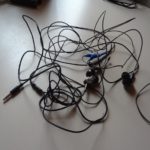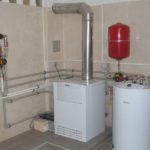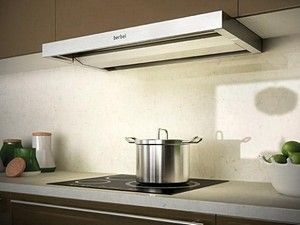How to calculate the power of a kitchen hood
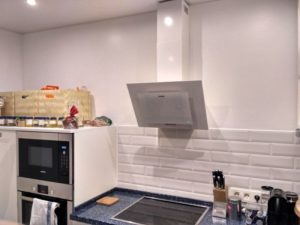 The kitchen is a special place in the apartment. Not only does the hostess spend a lot of time here, preparing delicious and healthy dishes. The whole family also often likes to gather here, in warmth and comfort.
The kitchen is a special place in the apartment. Not only does the hostess spend a lot of time here, preparing delicious and healthy dishes. The whole family also often likes to gather here, in warmth and comfort.
But if the room is filled with smoke and smoke, which also begins to penetrate into other rooms, there is no time for comfort here!
A useful device such as a range hood helps to avoid such trouble. However, this only happens if its power is selected correctly.
Let's figure out how to calculate it yourself.
But first of all, let’s clarify the basic information about exhaust devices. We will need it to perform accurate calculations.
The content of the article
The uniqueness of the kitchen hood
The function of hoods is to purify the air, remove dust particles, fumes, and fumes.
Features of the kitchen hood
Manufacturers offer several types of devices that make the air fresh and clean.
The main difference between them is related to technological features.Namely, what happens to the dirty air that gets into the hood body.
There are currently 2 operating options for the devices.
Inlet

Reference. These are powerful devices that can quickly and efficiently remove dirt.
They remove dirty air from the kitchen. Most often it is sent to the supply ventilation, which is available in the apartment.
Air movement occurs inside a special channel - an air duct. It combines the housing with the ventilation duct.
There are 2 types of air ducts
- The first option is a flexible, corrugated channel. It is usually used if an air duct with turns and corners is installed.
- Another option is to use hard plastic. Such an air duct is installed if the hood and ventilation are connected in a straight line that does not have any bends.
Recirculating
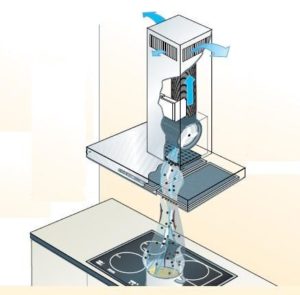
These are hoods that do not have access to ventilation.
This feature of the devices is related to the principle of their operation. The units do not remove dirty air, but clean it and then return it to the kitchen.
The absence of a ventilation duct led to the need to add another component to the design - one or more filters.
Reference. The power of recirculation hoods is usually somewhat less than that of supply structures.
Requirements for installing a hood
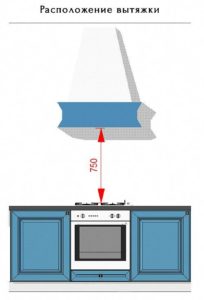
To perform their functions efficiently, the units must be installed correctly.
The place for them is related to the location of the cooking device: electric or gas stove (panel). The hood is installed directly above them.
Important: the width of the hood cannot be less than the width of the hob.
It is not allowed to place the stove and hood in different places in the kitchen.
Regardless of the principle of operation and power, exhaust devices can be mounted on the wall (flat, dome), on the ceiling (island), in a cabinet (built-in).
An important factor when choosing a location is the convenience of connecting the structure to electricity.
This information will help you decide which unit is best for your kitchen.
Power is an important parameter for choosing a device
Having decided on the type, design, operating features and mounting of the unit, you need to remember about its power.
What is hood power
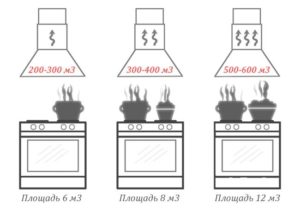
In physics lessons at school, we were taught that the concept of power indicates the speed of conversion, the performance of the main function of the device.
What does this mean in relation to a hood? Since the purpose of this household appliance is related to air purification, we will be able to determine what its power is. Therefore, the unit of measurement for this indicator became m³/h.
Power is also called device performance.
This indicator should not be confused with energy consumption data, which is also in some cases called power. The fact that these are different characteristics can be seen by comparing the units of measurement. Electricity consumption is measured in kWh.
What power do modern hoods have?

Depending on their specific needs, buyers can choose household appliances with different power ratings.
- Low-power units are produced with a capacity of 25 cubic meters per hour. This group includes equipment with characteristics up to 150-200 cubic meters per hour.
- Average power is expressed in terms of 200 to 450 cubic meters per hour. Most devices have a capacity of 300 to 400 cubic meters per hour.
- Powerful devices are hoods that process from 500 to 750 cubic meters per hour.
The productivity of industrial equipment is even higher.It reaches up to 900 cubic meters per hour.
Reference. Modern devices provide the ability to regulate the power and speed of air purification. They have up to 5 power levels.
Data required for power calculation
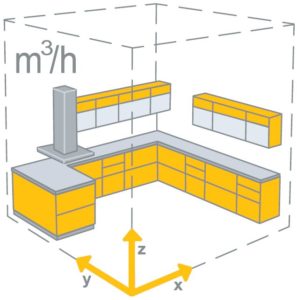
So, we have clarified what is included in the very concept of power. We also found out that we have great opportunities for choosing an exhaust device of suitable performance.
Important! A small kitchen area is not a reason to purchase appliances with minimal power.
But this only complicates the task! How to choose the most suitable one from a large number of devices?
The answer is simple: for each specific kitchen you will have to calculate the optimal hood power. And then all that remains is to purchase the device using the calculated data.
Sanitary standards
The calculation can only be correct if all the necessary data is used.
These primarily include sanitary standards. They are established by law.
Reference. In accordance with the requirements of sanitary rules and regulations in the kitchens of residential buildings, the air must be completely renewed 12 times in 1 hour.
Let's remember this number. We will need it for calculations.
An air turnover coefficient of 12 applies to all residential premises, regardless of their size and location (apartment building or individual building).
Formula
Let's move on to further calculations. They must be accurate, so mathematics is indispensable.
Calculations are carried out using the following formula: S x H x 12 = P.
To calculate we need the following data:
- Kitchen area – S.
- Ceiling height – H.
As a result, we obtain the required performance indicator (P).
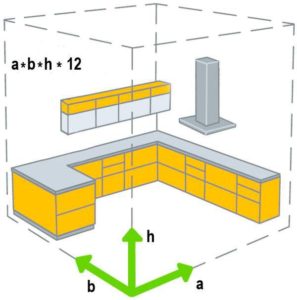
As you can see, there is nothing complicated.By multiplying the area and height of the room, we first find out the volume of the kitchen in cubic meters. And then we increase the result using the sanitary coefficient.
Help: the area is calculated by multiplying the length and width of the kitchen. Ready-made data can also be found in the technical passport of the apartment.
This determines the overall power of the device. However, this indicator is not final.
3 ways to count
There are different ways to find out what the performance of a structure working in your kitchen should be. Let's present 3 main methods that consumers are recommended to use.
According to the table
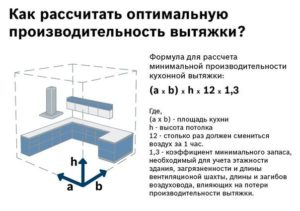
Since we use this formula to find out the maximum performance of hoods, it means that we will always have to use them to the maximum. How will this affect the device? It can be assumed that such functioning will not have the best effect on its longevity.
This means you need to buy a model more powerful than the data obtained. Therefore, a certain safety margin, expressed as a factor of 1.3, is included in the calculations.
Getting the result
For simplicity, you can use ready-made tables, which are compiled using an average magnifying factor of 1.3.
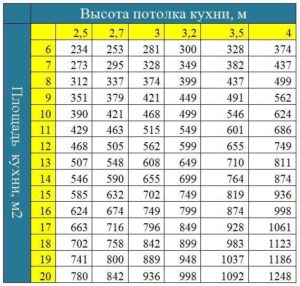
This is the easiest way. In the left vertical column we find the required area, in the upper horizontal column - the height of the room. At the intersection of the horizontal and vertical lines we find our data. The safety margin is already taken into account in them.
Subject to specific conditions of use
To obtain a more accurate result, you need to pay attention to the specific conditions of the room in which the structure will be installed.
Additional factors affecting hood power

And in order to match the hood with a specific kitchen as accurately as possible, you need to include additional information in the calculations.
Coefficients for different panels:
- gas – 2.0;
- electric – 1.5.
- models with an air duct – 1.3.
- models with filter – 1.7.
The largest coefficient is entered into the formula.
So, if the surface is gas (2.0) with a filter (1.7), we use a coefficient of 2.0.
And if the panel is electric (1.5) with a filter (1.7), our coefficient is 1.7.
Important! If there are smokers in the family, the power must be increased using an additional factor of 1.3.
Calculation examples
As an example, let’s make a joint calculation for different areas of kitchens.
9 sq. m
Initial data
- Ceiling – 2.5 m.
- The panel is gas (2.0), with a filter (1.7), therefore, our coefficient is 2.0.
9 sq. m x 2.5 m x 12 x 2.0 = 540 cubic meters. m/h.
10 sq. m
- Ceiling – 2.7 m.
- Electrical panel (1.5) with air duct (1.3) – increasing factor 1.5.
10 sq. m x 2.7 m x 12 x 1.5 = 486 cubic meters/hour.
12 sq. m
- Ceiling – 3 m
- Electrical panel (1.5) with filter (1.7) – coefficient 1.7.
12 x 3 x 12x 1.7 = 734 cubic meters/hour.
15 sq.m
- Ceiling – 2.7
- Electrical panel (1.5) with air duct (1.3) – coefficient 1.5.
15 x 2.7 x 12 x 1.5 = 729 cubic meters/hour.
Third way

Experts offer another simple method, which is the most common.
It is associated with an increase in the air turnover ratio.
In accordance with this technique, instead of multiplying by 12, another coefficient is used.
- Electric stoves – 15.
- Gas surfaces – 20.
Calculation examples
Let's see what results we get in our examples.
9 sq. m
Initial data
- Ceiling – 2.5 m.
- The panel is gas.
9 sq. m x 2.5 m x 20 = 450 cubic meters. m/h.
10 sq. m
- Ceiling – 2.7 m.
- Electrical panel.
10 sq. m x 2.7 m x 15 = 405 cubic meters/hour.
12 sq. m
- Ceiling – 3 m.
- Electrical panel.
12 x 3 x 15 = 540 cubic meters/hour.
15 sq.m
- Ceiling – 2.7 m.
- Electrical panel
15 x 2.7 x 15 = 607 cubic meters/hour.
As you can see, this simplified calculation gives slightly different figures.
They can be used as a guide as a minimum power indicator that a kitchen hood should have.
It is up to you to decide which method to use to calculate the power before purchasing.
We hope that the question of which hood to choose will not be too difficult now. You will be able to purchase a unit that will not only fit perfectly into the interior, but also cope with its purpose. Thanks to the correct selection of equipment, you will always be able to keep fresh air in the kitchen.


